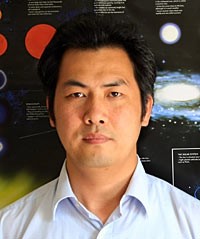MICROS: NOAA’s Infrared Satellite Monitoring System and the Community Radiative Transfer Model
XingMing Liang1,2
1 NOAA Center for Satellite Application and Research (STAR), College Park, MD 20740
2 CSU, Cooperative Institute for Research in the Atmospheres (CIRA), Fort Collins, CO 80523
Abstract
Forward radiative transfer calculations are routinely performed in the NOAA Advanced Clear Sky Processor for Oceans (ACSPO) Sea Surface Temperature SST (SST) retrieval system, using fast Community Radiative Transfer Model (CRTM), in conjunction with first guess SST and atmospheric profiles. Top-of-atmosphere brightness temperatures (BT) over clear-sky ocean are simulated in three window bands centered at 3.7, 11 and 12 µm. Model BTs are employed for improved cloud screening, exploring physical SST retrieval, and monitoring and validating satellite BTs.
Monitoring of IR Clear-Sky Radiances over Oceans for SST [MICROS; www.star.nesdis.noaa.gov/sod/sst/micros]near-real time online system was established to monitor model minus observation (M-O) biases in clear-sky BTs and SSTs produced by ACSPO. Currently six AVHRRs (onboard NOAA-16, -17, -18, -19 and Metop-A and -B), two MODISs (onboard Terra and Aqua), and VIIRS (onboard the Suomi-NPP) are monitored in MICROS. The key objectives are to fully understand and reconcile CRTM and sensor BTs and to minimize cross-platform biases, through improvements to the “M” (i.e., improved CRTM implementation including its inputs) and “O” (i.e., improved sensor calibration) terms.
This presentation summarize CRTM applications in MICROS and discuss ongoing work and future plans. The author suggest that the same methodology in MICROS can be extended to other remote sensing community.
 Xingming Liang is a senior scientist of NOAA / NESDIS / STAR, affiliated with the Cooperative Institute for Research in Atmosphere (CIRA) of Colorado State University. He specializes in the development of Monitoring of IR Clear-Sky Radiances over Oceans for SST (MICROS) and Aerosol Quality Monitor (AQUAM). He is a key developer of the NOAA Advanced Clear-Sky Processor for Oceans (ACSPO) SST product who takes charge of the implementation of radiative transfer model in ACSPO. Before joining NOAA in 2007, Xingming was a postdoc in Institute of Ocean Energy (IOES) Saga University, Japan from 2005 to 2007. He earned his Ph.D. degree in remote sensing from Saga University in 2005 and Bachelor of Engineering Machinery from Jilin University in 1992.
Xingming Liang is a senior scientist of NOAA / NESDIS / STAR, affiliated with the Cooperative Institute for Research in Atmosphere (CIRA) of Colorado State University. He specializes in the development of Monitoring of IR Clear-Sky Radiances over Oceans for SST (MICROS) and Aerosol Quality Monitor (AQUAM). He is a key developer of the NOAA Advanced Clear-Sky Processor for Oceans (ACSPO) SST product who takes charge of the implementation of radiative transfer model in ACSPO. Before joining NOAA in 2007, Xingming was a postdoc in Institute of Ocean Energy (IOES) Saga University, Japan from 2005 to 2007. He earned his Ph.D. degree in remote sensing from Saga University in 2005 and Bachelor of Engineering Machinery from Jilin University in 1992.

